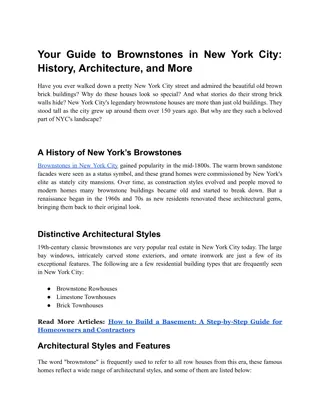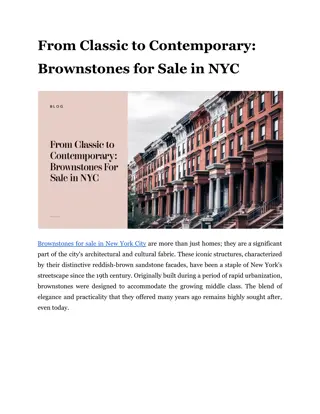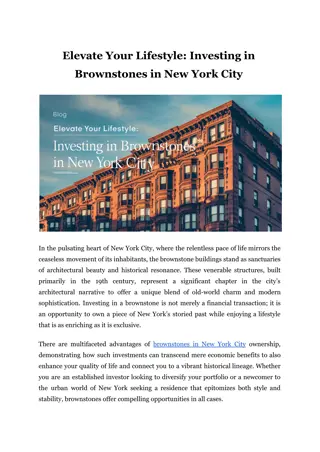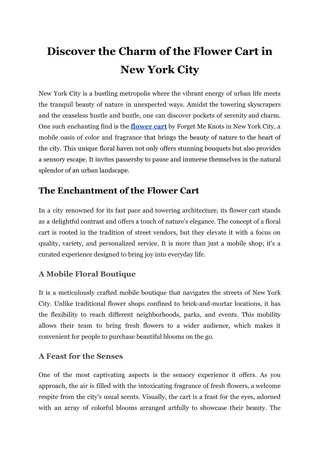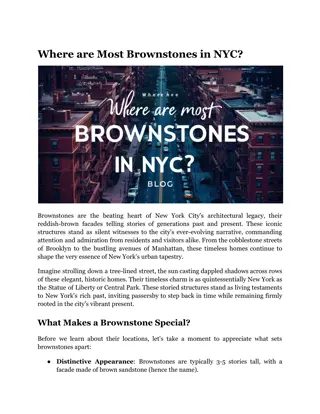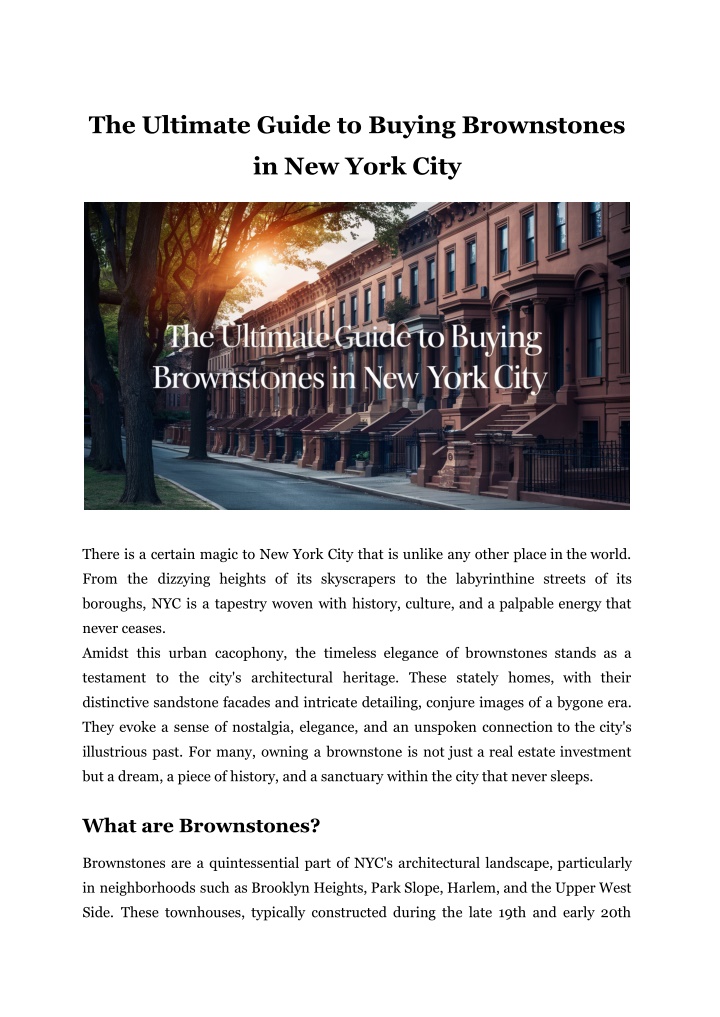
The Ultimate Guide to Buying Brownstones in New York City
Discover expert tips for buying brownstones in NYC. From pricing to neighborhoods, get the insights you need.n
Download Presentation

Please find below an Image/Link to download the presentation.
The content on the website is provided AS IS for your information and personal use only. It may not be sold, licensed, or shared on other websites without obtaining consent from the author. If you encounter any issues during the download, it is possible that the publisher has removed the file from their server.
You are allowed to download the files provided on this website for personal or commercial use, subject to the condition that they are used lawfully. All files are the property of their respective owners.
The content on the website is provided AS IS for your information and personal use only. It may not be sold, licensed, or shared on other websites without obtaining consent from the author.
E N D
Presentation Transcript
The Ultimate Guide to Buying Brownstones in New York City There is a certain magic to New York City that is unlike any other place in the world. From the dizzying heights of its skyscrapers to the labyrinthine streets of its boroughs, NYC is a tapestry woven with history, culture, and a palpable energy that never ceases. Amidst this urban cacophony, the timeless elegance of brownstones stands as a testament to the city's architectural heritage. These stately homes, with their distinctive sandstone facades and intricate detailing, conjure images of a bygone era. They evoke a sense of nostalgia, elegance, and an unspoken connection to the city's illustrious past. For many, owning a brownstone is not just a real estate investment but a dream, a piece of history, and a sanctuary within the city that never sleeps. What are Brownstones? Brownstones are a quintessential part of NYC's architectural landscape, particularly in neighborhoods such as Brooklyn Heights, Park Slope, Harlem, and the Upper West Side. These townhouses, typically constructed during the late 19th and early 20th
centuries, are named after the brown sandstone used for their facades. This material was chosen for its durability and aesthetic appeal, resulting in the warm, inviting exteriors that are now so beloved. Read More Articles: Enhance Your Security: Expert CCTV Installation in Atlanta Key Considerations Before Buying 1. Budget and Financing The first step in purchasing a brownstone is to determine your budget. Brownstones for sale in New York City can be significantly more expensive than other types of properties due to their historical value and prime locations. Hence, ensure you have a clear understanding of your financing options, including mortgage pre-approval, as this will streamline the buying process. 2. Location The neighborhood you choose will profoundly impact your lifestyle and investment. Areas like Brooklyn Heights offer a quaint, historic charm with easy access to Manhattan, while Harlem boasts a vibrant cultural scene. Research different neighborhoods to find the one that best aligns with your preferences and needs. 3. Condition of the Property Many brownstones require extensive renovations, especially if they have not been updated in several decades. Conduct a thorough inspection to identify any structural issues, plumbing problems, or electrical deficiencies. Understanding the property's condition will help you estimate renovation costs and avoid unexpected expenses. 4. Historical Preservation Brownstones often fall under historical preservation guidelines, restricting certain modifications to maintain their historical integrity. Familiarize yourself with these regulations to ensure your renovation plans comply with local preservation laws.
5. Space and Layout Consider your space requirements and the brownstone's layout. Many brownstones are multi-story buildings, which can be advantageous for creating separate living areas or rental units. However, be mindful of accessibility and potential mobility issues with the stair-heavy design. Understanding the Buying Process 1. Engage a Real Estate Agent Working with a real estate agent who specializes in brownstones in New York City can provide invaluable insights and streamline your search. They can help identify properties that meet your criteria and negotiate the best price. 2. Property Search Begin your property search with a clear list of must-haves and deal-breakers. Attend open houses and schedule private viewings to get a feel for the properties. Take note of the neighborhood's ambiance, amenities, and proximity to public transportation. 3. Making an Offer Once you've found a brownstone that meets your requirements, it's time to make an offer. Your real estate agent will assist in determining a competitive offer price based on market trends and property conditions. Be prepared for negotiations, as the seller may counter your initial offer. 4. Home Inspection A thorough home inspection is crucial to uncover any hidden issues. Hire a licensed inspector to evaluate the property's structure, systems, and overall condition. Use the inspection report to negotiate repairs or adjustments to the purchase price if necessary. 5. Securing Financing With your offer accepted, it's time to finalize your financing. Provide your lender with all required documentation to secure your mortgage. Additionally, make sure you
understand the terms of your loan, including interest rates, repayment schedules, and any associated fees. 6. Closing the Deal The closing process involves signing the final paperwork and transferring ownership of the property. This stage includes paying closing costs, which can include attorney fees, title insurance, and taxes. Once all documents are signed and funds are transferred, you'll receive the keys to your new brownstone. Read More Articles: Seeing is Believing: CCTV Installation Services Tailored for Atlanta Businesses Understanding the Renovation and Restoration Procedure Owning a brownstone often entails significant renovation and restoration work to preserve its historical charm while modernizing its amenities. Here are key aspects to consider: 1. Hiring Professionals Engage experienced architects, contractors, and interior designers who specialize in historic properties. Their expertise will ensure that renovations comply with preservation guidelines and enhance the property's value. 2. Permits and Approvals Secure all necessary permits and approvals before commencing any renovation work. This process can be lengthy, so factor it into your timeline. Working with professionals who are familiar with local regulations can expedite this step. 3. Restoring Original Features Preserve original features such as moldings, fireplaces, and woodwork wherever possible. These elements contribute to the brownstone's character and historical significance. You may use high-quality materials and craftsmanship to restore these features authentically.
4. Modernizing Systems Upgrade outdated plumbing, electrical, and HVAC systems to meet modern standards. Take some time to guarantee that these updates are seamlessly integrated with the property's historic elements to maintain its aesthetic appeal. 5. Enhancing Energy Efficiency Implement energy-efficient solutions such as insulated windows, solar panels, and energy-efficient appliances. These upgrades can reduce utility costs and increase the property's sustainability without compromising its historical integrity. Conclusion Purchasing a brownstone for sale in New York City is a unique and rewarding investment that combines historical charm with modern living. From budgeting and location selection to renovation and restoration, each step requires careful planning and expert guidance. So, it is important to collaborate with the best real estate agents in NYC to make an informed choice. Are you amazed by the structural beauty of brownstones in New York City? Or do you find it simpler and more reasonable to reside in a brownstone than a villa in NYC? Well, regardless of what impresses you, our expert realtors at The Boland Team NYC have got you covered with their expertise! So, get in touch with us now to see a variety of brownstones in multiple neighborhoods of this beautiful city! Site Article: The Ultimate Guide to Buying Brownstones in New York City




